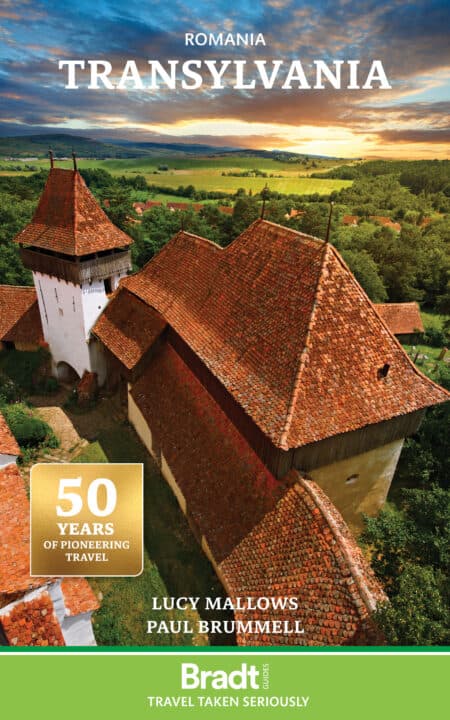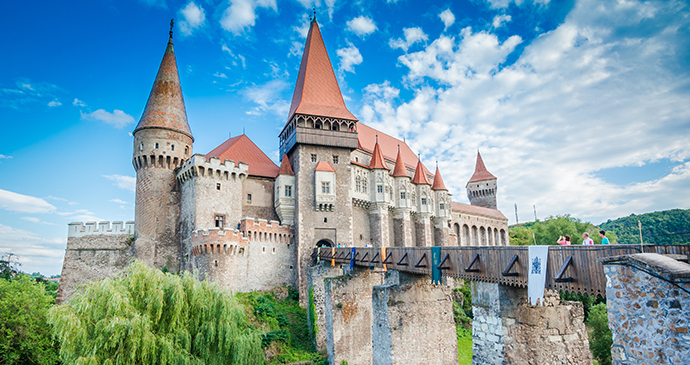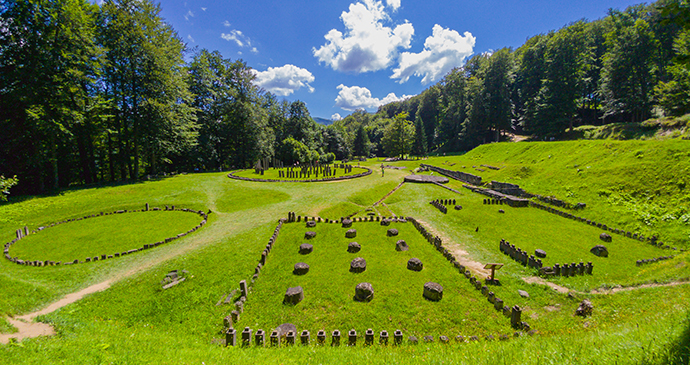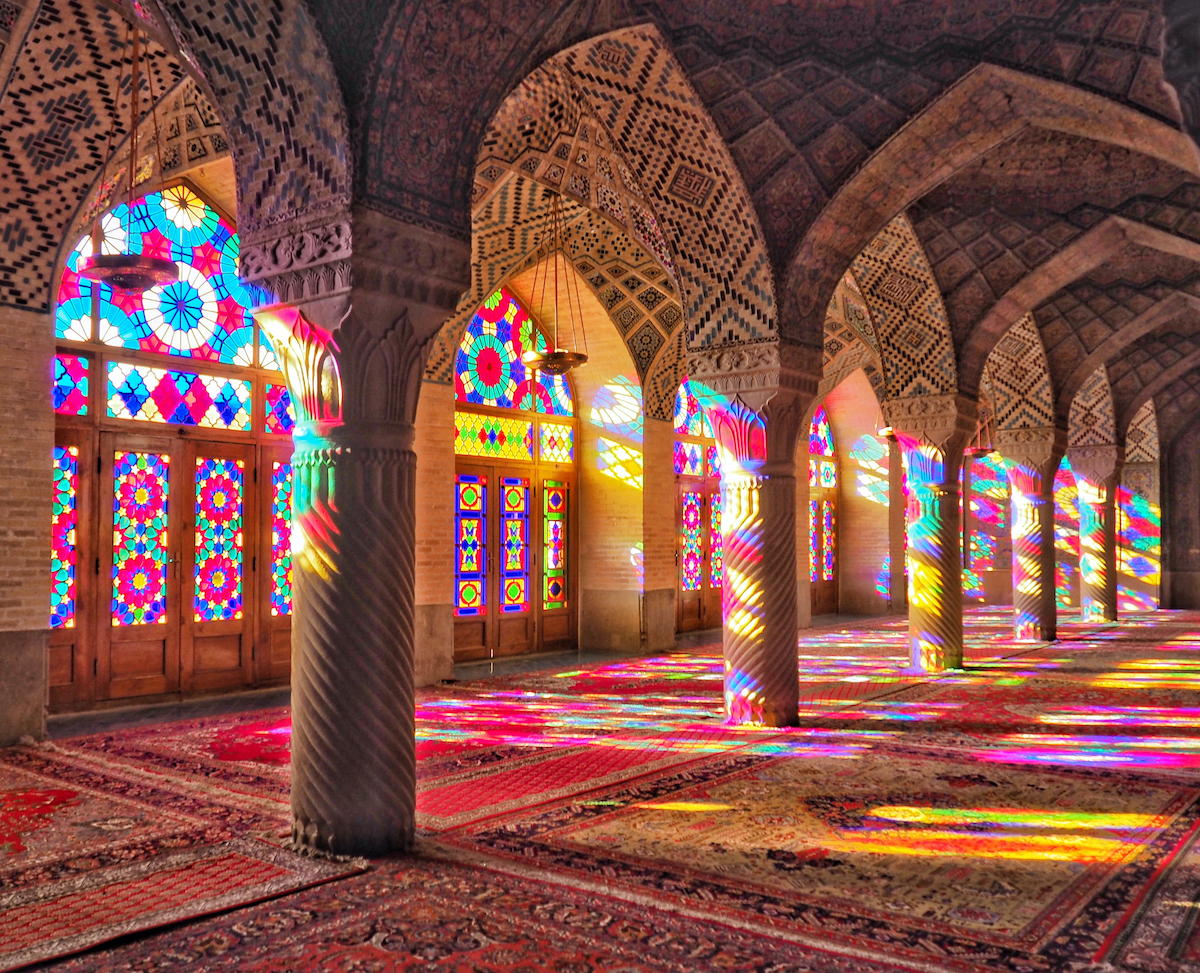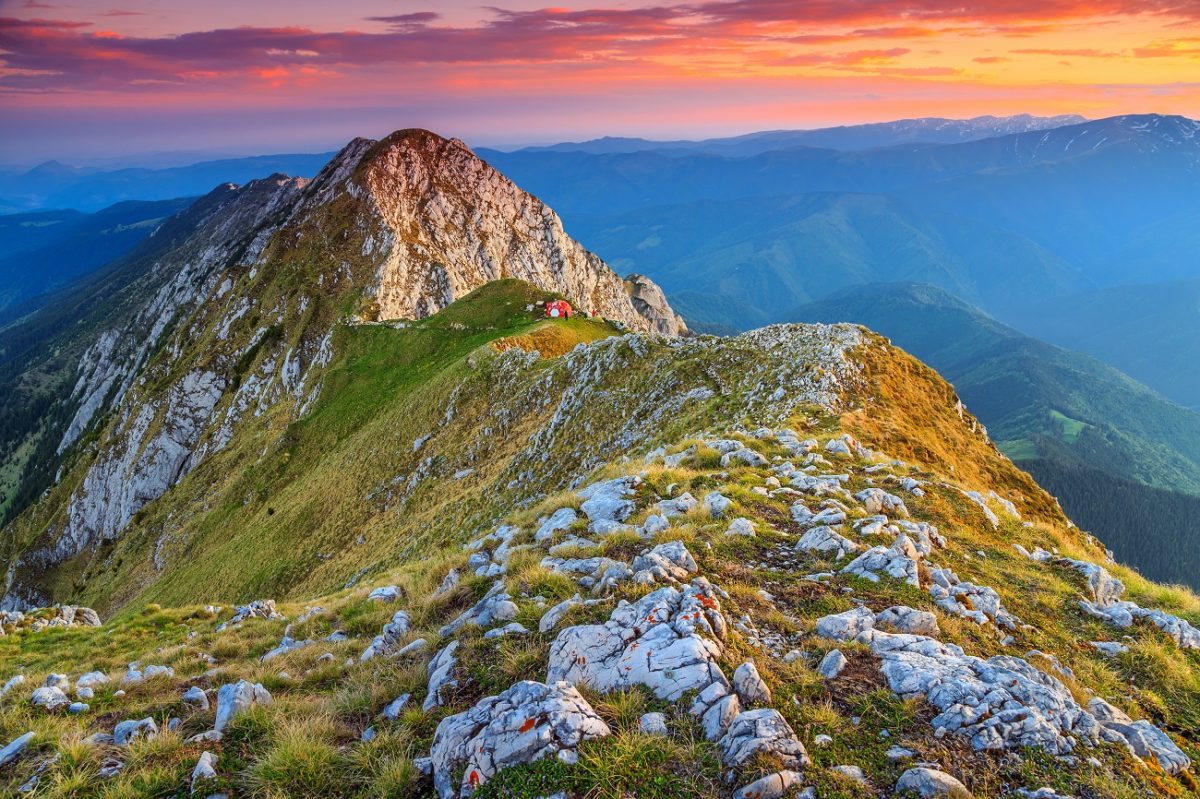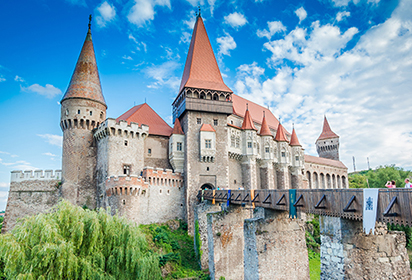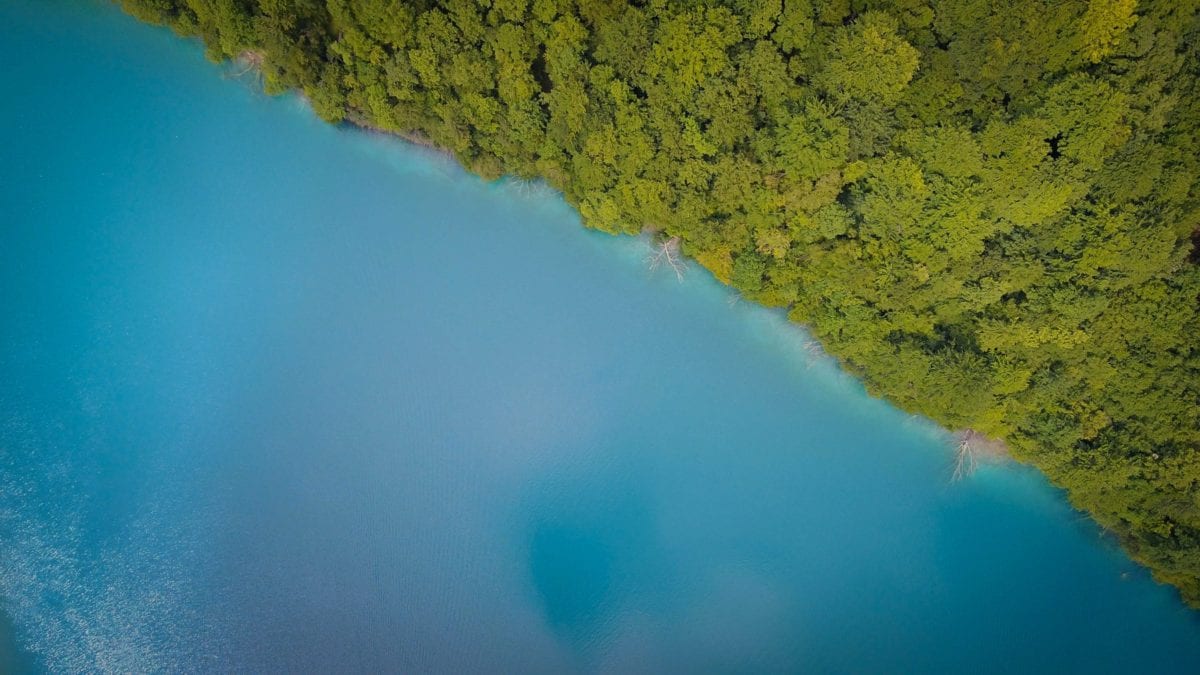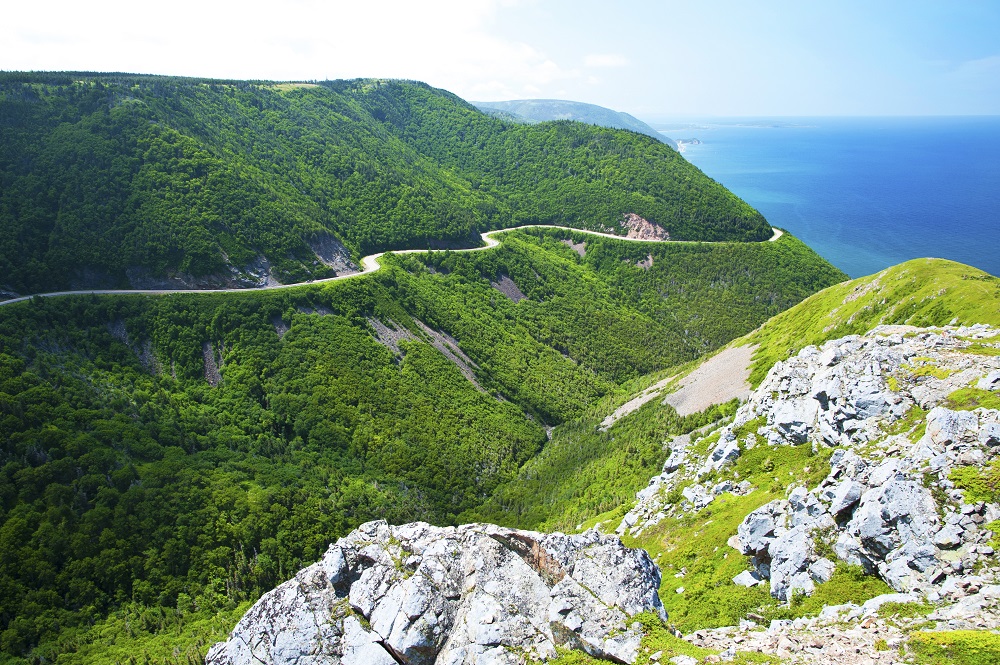The real Transylvania, the land beyond the forest, is a place captured within the sheltering arc of the Carpathian Mountains. Its upland forests hold some of Europe’s most important populations of bears, wolves and lynx, while further down the hillsides its meadows, still cut by scythe, play host to a late spring pageant of glorious wild flowers.
Lucy Mallows and Paul Brummell authors of Transylvania: The Bradt Guide
Transylvania, literally the ‘land beyond the forest’, is a wild, wooded, romantic region, filled with mountains, gorges and valleys, myths and legends, bears, wolves – some say werewolves too – and legends of dragons and vampires.
The land that time forgot is a rural paradise: Bram Stoker called it: “one of the wildest and least-known parts of Europe” and little has changed in a century. Considered by many the most beautiful region in Eastern Europe, Transylvania preserves its medieval cultural and artistic treasures in an unspoilt landscape. The real Transylvania is more intriguing than any fairytale and it’s the perfect holiday destination for those travellers wanting to escape the modern high tech world.
Visitors can discover the spooky Murderer’s Lake, wander through hidden Saxon villages of Biertan and Viscri, slip into frescoed interiors of fortress churches or soothe weary limbs at scenic spa resorts. The more adventurous travellers can climb along the precipitous walls of Bran Castle and seek out the myth behind the bloodthirsty Count Dracula. Holidaymakers can even stay with a real-life Transylvanian count, in a British prince’s guesthouse or live it up at a boutique hotel in a sensitively-restored medieval city such as Sibiu or Brasov.
A highlight is the chance to experience true Transylvanian hospitality; visitors can explore the mountains, go bird-watching, bear-tracking and looking for lynx, led by expert local guides, then enjoy Transylvanian hospitality; home-cooking with delicious fresh vegetables, fruits, cheeses and meats, washed down with herbal teas and fiery spirits.
It’s possible to trek or horse-ride for miles through untouched, fence-free mountain wilderness in four outstanding national parks, while two giant salt mines at Praid and Turda offer an unusual glimpse into Transylvania’s underworld. Transylvania is bordered on three sides by the Carpathian Mountains and holds Romania’s best hiking and skiing holiday destinations. The slopes and resorts are perfect for young families and the scenery guarantees the trip of a lifetime.
For more information, check out our guide to Transylvania
Food and drink in Transylvania
Food
The cuisine of Romania is a reflection of the country’s history and geographical location. Transylvanian cuisine (you will also hear it expressed as ardelean) reflects the wider array of Romanian dishes, but with a stronger influence from Hungarian and German ideas and flavours, with Hungarian dishes such as chicken paprikash featuring on menus.
Breakfast
Breakfast is often quite a simple affair enhanced with natural local produce. Crusty bread (pâine) is accompanied by homemade jam (gem). Many small guesthouses offer their own yoghurt and the honey may have come from local beehives. Lorries with many-coloured hives installed in the side tour the countryside pursuing the best blossoms. Acacia honey (salcâm) is particularly good. There may also be cheese (brânză), perhaps a Cheddar-like caşcaval or the unsalted semi-soft ewe’s milk caş, a feta-like cheese, sometimes mixed with fresh dill and stuffed into fresh peppers. Two great spreads, often found at breakfast buffets in hotels, are the green salată de vinete, made from aubergines, and the reddish zacuscă, which may contain various vegetables but usually includes peppers, tomato, onion and carrot.
Snacks
One of the delights of Romanian towns is the hole-in-the-wall places that specialise in freshly made snacks (gustări) and pastries, notably covrigi, spirals of salted bread shaped like pretzels. These come in various flavours, from simple affairs with a topping of sesame seeds to more complex concoctions filled with cherry jam or chocolate. They are cheap and very good. More elaborate and sweeter Romanian snacks include gogoşi, sweet doughnuts and papanaşi, cheese-filled pastries slathered with cream and jam.
In areas with a large ethnic Hungarian population, notably Mureş, Harghita and Covasna counties, and at fairs and markets everywhere in Transylvania, you will also come across typically Hungarian snacks, notably lángos, giant frisbees of deep-fried dough, served with an imaginative selection of toppings: sour cream, grated cheese, ketchup or even cabbage. A distinctive Székely culinary contribution is the chimney-shaped kürtös kalács, a hollow cylinder of sweet bread rolled in sugar, cinnamon, coconut or walnuts and cooked by wrapping it around metal poles on a kind of barbecue. It is fascinating to watch these being made on the spot.
Lunch and dinner
Lunch (dejunul/masa de prânz) is usually the main meal of the day for most Romanians. Dinner (cina) is more modest.
There is still an emphasis on meat in many restaurant menus and guesthouse offerings. Pork has a central place in the Romanian culinary consciousness, and the slaughter of a pig in the run-up to Christmas remains an important event in the calendar of many Romanian families. Vegetarians can ask for something fără carne, meaning ‘without meat’, or for mâncare de post, traditionally the dishes served during periods of fasting, observed by many Orthodox Romanians, when meat is avoided.
Soups are a very popular element of the Transylvanian diet. Romanians draw a fundamental distinction between an ordinary soup, or supă, and a sour soup, known as ciorbă or borş. Sour soups are prepared with the addition of a liquid, also called borş, made of wheat or barley bran fermented in water.
Mămăligă, made from stone-ground cornmeal (polenta) is the unofficial national dish and is as essential to Romanian cuisine as pasta is to Italian. It forms the basis of a large number of heavy but hearty dishes, such as bulz, an oven-roasted mix of mămăligă and cheese. You may also come across balmoş, a smooth and rich puree of corn flour and whey cream. Mămăligă also forms the chief accompaniment to many signature Romanian dishes. Pride of place here goes to sarmale (cabbage or sometimes vine leaves stuffed with minced pork).
Romanians are also highly attached to the barbecue (grătar). The distinctively Romanian contribution here are the little skinless sausages known as mititei or mici (literally ‘small ones’). You will see these being cooked up on roadside barbecues all over the region.
Drinks
Romanian restaurants often offer good homemade lemonade, which may be flavoured with ginger or other products. This is usually served up not in a glass, but in a jar with a straw, and sweetened with honey to taste. Another great nonalcoholic drink is must, freshly pressed grape juice which appears at the time of the autumn grape harvest.
Romania produces some good beers, usually served in a half-litre mug known as a halbă. A spriţ (spritzer) ofwhite wine mixed with sparkling mineral water is a popular summer drink. Mulled wine (vin fiert) with sugar and cinnamon is great on cold winter days. For something stronger, try ţuică fi artă (hot plum brandy with sugar and peppercorns).
Health and safety in Transylvania
Health
If you are living in one of the member states of the European Economic Area (EEA) plus Switzerland you should obtain a European Health Insurance Card (EHIC) before travelling to Romania, in order to allow free or reduced-cost access to healthcare provided by the statutory healthcare system. If you are resident in the UK you can apply for an EHIC on the NHS website, free of charge.
No vaccinations are legally required, but it is wise to be up to date with routine vaccinations such as the diphtheria, tetanus and polio and measles, mumps and rubella vaccines. Hepatitis A should also be considered – a viral infection which is spread by infected food and water. For those who are going to be working in hospitals or in close contact with children, or for those whose activities otherwise put them at increased risk, hepatitis B vaccination may be recommended. Typhoid vaccine may also be considered for longer-stay travellers.
A 2010 report by the Health Protection Agency in the UK categorised Romania as a country of intermediate-level risk for travellers’ diarrhoea, so you should exercise usual good practice around frequent hand-washing, choosing freshly prepared, well-cooked food served hot, and avoiding tap water if in doubt about the quality of the local water (although it is fine to drink in many places), but there is no need to get obsessive.
Rabies has been reported in both domestic and wild animals in Romania. Visitors should be wary of, and try to avoid, contact with stray dogs and sheepdogs guarding flocks in the mountains. But remember rabies can be carried by any warm-blooded mammal and not just dogs! If bitten, scratched or simply licked visitors should thoroughly clean the wound immediately with soap and water, and seek an urgent local medical assessment, even if the wound appears a minor one.
Another risk to be aware of is posed by the humble tick, again a particular concern for trekkers, mountain-bikers and anyone whose Romanian holiday plans are more focused on the countryside than the cities. Ticks are most active between spring and autumn, and typically at altitudes below 1,500m. Infected ticks can carry a viral infection called tick-borne encephalitis (TBE). The foothills of the Carpathians in Transylvania are among the areas presumed to be infected. You may wish to ask about vaccination, particularly if planning to camp or hike in Transylvania. The website Tick Alert has more information about TBE.
Lyme disease is another infection spread to humans by ticks, and in this case there is currently no vaccine available to prevent it. The most distinctive symptom, though not everyone with Lyme disease experiences it, is a circular rash at the site of the bite, usually between three and 30 days after being bitten, often described as similar in appearance to the bull’s-eye on a dartboard. Fever, chills, fatigue, muscle aches and a headache may accompany the rash. Early treatment, usually by means of antibiotics, should prevent the emergence of more serious later symptoms.
Mosquitoes can be irritating, but fortunately not more than that, as Romania does not fall within a malarial area. Take a good supply of insect repellent and cream. Other health risks to be aware of are those connected with the sun and altitude.
Travel clinics and health information
A full list of current travel clinic websites worldwide is available on ISTM. For other journey preparation information, consult NaTHNac (UK) or CDC (US). Information about various medications may be found on NetDoctor. All advice found online should be used in conjunction with expert advice received prior to or during travel.
Safety
The vast majority of visits to Romania are trouble-free, and Transylvanian cities and villages alike are welcoming and feel safe. Violent street crime is very rare in Romania. In many villages, where everyone knows everyone else, doors are left open and children run around until late at night. As anywhere though, you should maintain a good level of personal security awareness. Petty theft does occur, with pickpockets operating in crowded places frequented by tourists, including airport terminals and railway stations, and on public transport, especially busy buses. Thefts of valuables from hotel rooms are also a risk, as worldwide, and you should use hotel safes if available. There are occasional reports of scams, sometimes involving thieves impersonating plain-clothes policemen and asking to check documents as a way of trying to syphon away some cash, or involving demands for on-the-spot payments of fines for fictitious offences. The incidence of this type of activity seems to be declining, and you are highly unlikely to encounter anything like this.
The tragic fire at the Club Colectiv nightclub in Bucharest on 31 October 2015, which resulted in the deaths of 64 people, highlighted the risks of some venues circumventing fire safety and other rules. If you do not feel safe in a club or restaurant, you might wish to choose somewhere else.
Road safety is an issue in Romania, and the statistics are not at all encouraging. Road deaths in Romania in 2015, for example, equated to 9.5 per 100,000 people, against 2.8 in the UK over the same period. Aggressive and poor driving seem to go hand in hand in Romania, and the risks are compounded by the sheer variety of vehicles on many Romanian roads, all travelling at different speeds, from horsedrawn carts to BMWs. Constant vigilance is required when driving a hire car. If you are unlucky enough to have an accident, do not leave the site or attempt to move the car. You should call the police and make sure that you obtain a copy of the police report, as you will need it for your insurers.
In an emergency
The common phone number for all emergency services in Romania is 112. It covers the police, ambulance, General Inspectorate for Emergency Situations, gendarmerie (an agency with military status responsible for defending public order) and SMURD, a mobile emergency service for resuscitation and extrication. Call centres are usually able to respond in English. The only additional emergency number you might need, and should have ready if you are planning any climbing or remote trekking in Romania, is that of the mountain rescue service Salvamont: 0725 826 668, or 0Salvamont for phone keypads featuring letters as well as numbers.
Female travellers
Conservative attitudes are still pretty common in Transylvania, and women travelling on their own are likely to encounter some surprise from the locals at the idea, particularly if the women in question should enter such traditionally male preserves as the village bar. But with the right precautions and security awareness it is unlikely to be a dangerous experience, and Transylvanian friendliness and hospitality usually win out. While you will see women of all ages hitchhiking, particularly in rural areas with little or no public transport, it would, however, be particularly risky for a single woman traveller to attempt to do so.
Travelling with children
Transylvania can be a great place to travel with children, given the diversity of its attractions and links to all sorts of themes that fascinate young ones, from vampires to dinosaurs, medieval knights to bears. Entrance tickets for children to most attractions are considerably reduced. Many hotels offer cots for babies and small children; you are more likely to have to pay a charge for these at more expensive hotels, while they are often given free of charge where available at pensions. Highchairs for children are available in many restaurants.
Travellers with a disability
Disabled travellers will find Transylvania a challenge. Its towns, with their winding, cobbled streets, frequently with cars parked astride pavements, are not wheelchair-friendly. Buses in some cities offer wheelchair access, but these are still far from the standard. And a surprisingly large number of hotels and guesthouses lack lifts. Awareness in Romania of the needs of disabled people is patchy too. A Bucharest based charity providing training for guide dogs for the blind found during trials in local stores and supermarkets that many outlets were unwilling to grant an exception to their policies of no dogs in the store to guide dogs.
There are signs of positive changes being made, including the provision of ramps to allow wheelchair access to banks and hotel receptions. But it still seems in all too many towns that, for every accessible restaurant, there are half a dozen more for which the only access is down a steep flight of stairs. One relative exception to the overall somewhat gloomy picture is in the more modern of the spa resorts, where hotels are more likely to offer spacious lifts and rooms fitted out to meet the needs of guests with disabilities. Romanians are, however, very willing to help where they can. Useful sources of general information for travellers with disabilities include the website of Tourism for All UK, the Rolling Rains Report and the UK Government’s site.
LGBTQ+ travellers
The lesbian and gay community in Romania faced persecution during the Communist period. Article 200 of the Penal Code, introduced by Ceauşescu in 1968, criminalised homosexual relationships. The repeal of the last vestiges of Article 200, and thus the final decriminalisation of all same-sex sexual activity, only took effect in 2002. Attitudes towards gays, lesbians, bisexual and transgender people are often unsympathetic, and at the time of writing a campaign was underway promoted by a group of organisations calling themselves the Coalition for Family for a referendum aiming to revise the Constitution in such a way as to prevent any possibility of the introduction of gay marriage in Romania.
The major non-governmental organisation in Romania campaigning for the rights of lesbian, gay, bisexual and trans-gender people is Asociaţia ACCEPT, which organises the annual Bucharest Pride parade in May. The university city of Cluj-Napoca has a reputation as the most gay-friendly city in Transylvania, and has a number of gay and gay-friendly bars and clubs. Elsewhere, conservatism tends to increase with decreasing settlement size. You are less likely to face prejudice when booking into larger hotels than family-owned guesthouses, but of course there are many exceptions. And it would be wise to be cautious about public displays of affection, especially in smaller communities.
Travel and visas in Transylvania
Visas
Romania became a member of the European Union on 1 January 2007, although at the time of writing it is not part of the Schengen Agreement, between whose member states internal border checks have largely been abolished, although has applied to join. However, for visitors coming for stays of less than 90 days, travel from all EU but also many other countries, including the USA and Canada, is visa-free and straightforward.
Entry requirements
At the time of research, the citizens of some 58 countries do not need a visa to enter Romania as a tourist for stays of up to 90 days, including UK and all EU citizens and those of Canada, the USA, Australia, New Zealand, Israel and Japan (full list on the Ministry of Foreign Affairs website). EU citizens may enter the country with their national identity card; all other visitors require a valid passport. It is recommended that passports are valid for at least six months from the date of travel, since some airlines refuse boarding if the passport is not valid for at least three months beyond the intended departure date.
Holders of passports not exempt from visa requirements must obtain a visa from a Romanian embassy outside Romania before travelling. For stays of up to 90 days, the visa requirement is exempted for holders of Schengen visas, even though Romania is not in the Schengen Agreement, but only if the Schengen visa allows for at least two entries in the Schengen space and both the number of entries and permitted length of stay have not been exhausted. The visa requirement may also be exempted for holders of national visas or residence permits issued by Schengen member states or permanent residence permits issued by the UK or the Republic of Ireland.
If you intend to stay longer than 90 days in Romania, whether for business, study or to carry out volunteer work, you will need a temporary residence permit. This must be applied for at the Immigration Office (Birou Imigrări) nearest to you, at least 30 days before the expiry of your current status. The contact details and opening hours of all of these are listed on the website of the General Inspectorate for Immigration.
This is a somewhat bureaucratic procedure, involving an application form, proof of employment, study or sufficient funds, and some additional requirements for non-EU citizens, including proof of accommodation. There are also some fees to pay: tiny but fiddly for EU citizens, rather more substantial for non-EU citizens.
Despite the red tape involved, please don’t be tempted to ignore the requirement to obtain a temporary residence permit as overstays can incur both a fine and a temporary ban on returning to Romania.
Getting there and away
By air
Transylvania has three international airports (Cluj-Napoca, Sibiu and Târgu Mureş), although the airport at Târgu Mureş was closed for repairs at the time of research. But many visitors arrive at the international airport in Bucharest, which offers a much wider range of flight destinations and is straightforward to access by both road and rail, albeit at the cost of bringing you into Romania outside of Transylvania itself. There are also longstanding plans to construct a further international airport at Ghimbav, just outside Braşov, although these have long been stalled.
Airlines serving Bucharest are a mix of traditional or legacy carriers (including the Romanian national carrier, Tarom) and budget airlines. The former are more likely to offer more central airports at your city of departure (in London, Heathrow, rather than Luton or Stansted), better baggage allowances and some in-flight catering, but at a higher ticket cost.
But the difference between the two types of airlines is gradually becoming less marked, particularly on the short European routes that make up the overwhelming majority of flights into Romania, as the legacy carriers trim all frills, including in-flight catering, and both types of airlines offer low prices for customers able to book their flights well in advance.
By train
It’s more expensive to travel to Transylvania by train (tren), but you can take your time, admire the view and feel good about decreasing your carbon footprint. Train tickets often allow stopovers en route, so train travel can be an affordable and relaxing way to include Romania in a European trip. The shortest London–Bucharest train journey takes about 36 hours, but you can choose from a variety of routes. If you are travelling from the UK, note that British railway stations generally do not sell international tickets, with the exception of the Eurostar office at London’s St Pancras station, which just sells tickets on that service to Paris and Brussels.
A possible journey from London to Transylvania could be to take the Eurostar to Paris Gare du Nord, then walk across to the Gare de l’Est. From there take a train to Munich, and the onward overnight sleeper to Budapest. Take a day to explore Budapest, before another night on an overnight sleeper, this time taking you to Braşov. Remember to always make reservations for sleepers.
By coach or bus
There is quite a number of long-distance coach connections between Romania and western European cities, including the UK. Prices are considerably cheaper than train travel, though will not necessarily work out less expensive than flying on a low-cost airline if you book your plane ticket well in advance. And you do spend a lot of time in a coach seat. Thus the Eurolines coach departing London Victoria at 23.00 on a Sunday evening does not arrive in Braşov until 19.00 on Tuesday. The services tend mostly to be used by Romanian migrant workers attracted by the more generous baggage allowance of coach services as against flying.
By car
It is possible to drive from the UK or continental Europe to Transylvania and do some sightseeing on the way. The shortest driving distance between London and Bucharest is around 2,500km, or 1,500 miles. That between London and Târgu Mureş is around 2,280km.
EU citizens can drive in Romania with the driving licence from their home country. Citizens of a range of other countries, including the USA, Canada, Australia and New Zealand, are also able to drive using their home-country driving licence for a period of 90 days from their arrival in Romania.
The other key piece of bureaucracy is that, whether you are driving your own car or a rental, you will need to obtain a vignette called a rovinieta, which is essentially a form of road toll. These can be purchased online, as well as at the border crossings, post offices and many petrol stations, and have a validity period of one, seven, 30 or 90 days, or one year. If you are travelling from the UK, note that some of the other countries you will pass through en route have their own form of vignette requirements, though in most of these, unlike Romania, vignettes are only required for travel on motorways
Getting around
Public transport in Transylvania is cheap but decidedly patchy. There is usually a good bus service between two reasonably large adjacent towns, but it can be limited or non-existent in more isolated areas. And although Romania has one of the densest train networks in Europe, the speed of travel is slow, frequencies can be limited and train times inconvenient. In rural areas with little public transport, the locals resort to hitchhiking. If your Transylvanian itinerary will take you away from the larger towns and cities for sustained periods then you are likely to be best off either hiring a car or arranging an organised or tailor-made tour.
By air
Until recently, the domestic flight network in Romania was the preserve of the Romanian state carrier Tarom, but routes are also now being served by the lowcost carriers Wizz Air and Blue Air, which has brought down prices.
By train
Romania has a dense railway network, with more than 10,000km of track, although less than half of this is electrified. The state railway company is Căile Ferate Române, universally known as CFR. The good news is that railways will take you between most cities and towns in Transylvania, and many small settlements, too; the bad news is hat they will rarely do so quickly.
There are several different types of train in Romania. InterCity (IC) trains are the fastest, most modern and comfortable. Unfortunately, they are few and far between, and only used on a few main routes. InterRegio (IR) trains will prove the mainstay of a train-based Transylvania tour.
By bus or coach
The Romanian bus network is not well integrated. It involves a plethora of private operators, with departures in larger cities, notably Braşov and Bucharest, from many different bus stations. The quality of the buses on inter-city routes varies enormously, and you might even find yourself on an airconditioned bus with a toilet, and even more rarely the latter might be working, but overall the buses tend to be older and less well-equipped than those of equivalent operators in western Europe. Buses in Transylvania are generally a feasible enough option between neighbouring largish towns, where the service frequency tends to be high, but are much less useful in rural areas. The Autogari website does a noble job of trying to keep track of the complex and fastchanging bus schedules.
By car
The road network in Transylvania is comprehensive, but highway infrastructure lags far behind that of much of western Europe, and overall travel speeds can be slow. Expect an average driving time of around 50km/h, although this masks sharp variations. There are two motorways (autostrăzi) currently under construction in Transylvania.
The A1 motorway will eventually run from Bucharest to Piteşti, then up the valley of the Olt River into Transylvania, then past Sibiu and Deva to the Hungarian border at Nădlac. The section between Bucharest and Piteşti has long been complete, but the rest is years late. The section between Sibiu and Deva is now operational, and has had the effect of considerably speeding up travel westwards into Hunedoara County.
The A3 motorway is planned to run from Bucharest up the Prahova Valley to Braşov, and thence to Făgăraş, Târgu Mureş, Cluj-Napoca and Oradea, before connecting with the Hungarian M4 motorway. Only two segments of this motorway have been completed: that from Bucharest to Ploieşti and a short section near Cluj between Câmpia Turzii and Gilău.
Car hire
Hire-car companies in Bucharest and the main towns in Transylvania offer a broad range of vehicles. The home-grown Dacia brand, a subsidiary of the French manufacturer Renault, is well worth considering.
The Dacia Logan is the favoured car of Romanian taxi drivers, and is a good economical choice, with engine sizes available between 1.0l and 1.5l. And if you are looking to tackle some tougher tracks the Dacia Duster 4×4, with engine sizes from 1.2l to 2.0l, is a good option – and fits a pushchair in the boot. If hiring a car in winter, make sure that it is fitted with winter or at least all-season tyres, and that it is equipped with a snow-scraper (racletă). When hiring a car in summer, it is worth paying extra for an option with air conditioning.
When to visit Transylvania
Romanian winters are cold, especially in the mountains and on the high plateaux of Transylvania. This is the most challenging time to travel, with some high mountain passes closed, but Transylvania also offers a range of winter pursuits. Snow cannons help to ensure good skiing at the most important winter resort, Poiana Braşov, from December to April, and there is skiing at a range of other upland resorts too, though the season may be shorter. Winter is also the time to try out the Hotel of Ice at Lake Balea. April and, especially, May bring forth the best of the wild flowers carpeting the hay-meadows of the Carpathian lowlands and, avoiding the searing heat of the summer, are generally an excellent time to visit Transylvania, though spring rains are a risk. The summer months are considered the peak tourist season, including for domestic Romanian tourists, but can sizzle, and the larger cities of Braşov, Sibiu and Cluj-Napoca in particular can be stifling in summer, although Cluj-Napoca is a major student city and quieter during the summer break. This is a good time to visit more mountainous destinations.
Climate
Romania has a temperate-continental climate, with four distinct seasons. The spring is pleasant with cool mornings and nights and warm days. Summer is hot, especially in the south of the country, where Bucharest has an average high temperature in July of almost 30°C. Summer temperatures in Transylvania are usually a few degrees cooler than this, with the average high temperature in Cluj-Napoca around 25°C in July, but air conditioning in both city hotel rooms and transportation is particularly welcome. High mountain areas in Transylvania still feel fresh in the summer months. During the summer, you might encounter an intense and violent thunderstorm, with dramatic displays of lightning and sudden bursts of torrential rain. Autumns are cool, with meadows and trees producing beautifully coloured foliage, making the landscape look like a pastoral painting.
Winters can be bitterly cold and snowcovered, especially in the mountains, where temperatures can drop to –20°C. The average high temperature in Cluj-Napoca in January is around 0°C. A bitter, icy wind called the crivăţ sears through from Siberia, though its effects are more strongly felt in southeastern Romania. Transylvania is, however, often hit by winter fog, which can ground early morning flights to Cluj-Napoca and make driving difficult. Falls of heavy snow are likely at some point between December and mid-March, although the onset of winter snows can vary considerably from year to year. Nonetheless, your chances of a white Christmas are pretty high in Transylvania: around 85% in Cluj-Napoca. And, buoyed by the advantages of snow cannons, the main ski resorts around Braşov are usually able to offer snow from December until April. If you are hiring a car in the Transylvanian winter, make sure it is equipped with winter tyres.
While autumn offers less meteorological predictability than the height of summer, it is also a good time to visit, as the leaves paint the landscape in beautiful hues and there are many festivals connected with the harvest.
Spring and autumn are best for tackling strenuous hiking routes and give good opportunities for wildlife-watching. Note too that many accommodation providers offer discounted rates away from the summer season. In more touristy places such as Braşov and Sighişoara the difference between high- and off-season rates can be considerable. Conversely, many attractions open for longer periods in summer.
What to see and do in Transylvania
Biertan: Saxon fortified church
Biertan (Berethalom/Birthälm) is a prosperous-looking large village whose central square is dominated by the large and impressive fortified church, which features defensive structures running down the hill towards the square. The church is one of those inscribed on the UNESCO World Heritage list in 1999, and among the largest and most visited of all the Saxon fortified churches of Transylvania. The first church was built here in the 14th century, but the present building dates from the start of the 16th, its size an indication of Biertan’s wealth, which was at least partly down to the local wine industry.
The ticket office for the church sells a range of guides (albeit mostly in German) and some postcards. From the ticket office, a restored covered wooden staircase heads up the hill. The staircase brings you out inside the inner of the two circles of defensive walls. There is also a third partial wall, all adding up to an impressive and complex array of defensive structures. The towers in the inner wall include the Catholic chapel, a place for prayer for those who did not convert to Protestantism, which features some late-Gothic frescoes. The building in the walls to the left of this, which currently houses a two-room museum, is apparently a place in which quarrelling couples were locked together, with just a single bed, plate, knife, fork and spoon, as a last-ditch attempt to see whether they could get on. Another tower houses tombstones of priests and bishops of the church, including Lucas Unglerus.
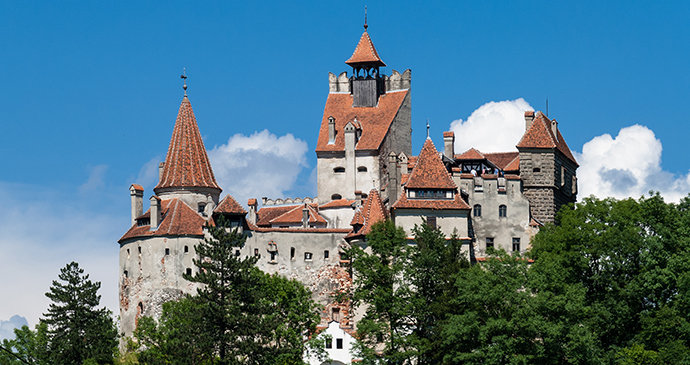
Bran Castle
The chief attraction of the village of Bran, Bran Castle does not disappoint. With its turrets, steep walls and imposing location atop a rocky crag, it looks every inch the Transylvanian castle, and this is the place visitors to Romania come in order to see the real Dracula’s home. Except that it isn’t. Author Bram Stoker located the castle of his fictional Count Dracula far to the north, near Bistriţa, although he probably saw drawings of Bran in the course of his research for the book, and its striking features may have been one source of inspiration for his fictional castle. And the castle had precious little connection either with Vlad the Impaler, the historical figure most linked to Count Dracula, beyond the possibility that he was briefly imprisoned here and the fact that he passed through the area in 1459 on his way to attack Braşov. While there are displays about Count Dracula and vampires in the castle, it is best appreciated by putting Dracula to one side and focusing instead on the real history of the place, which is of great interest.
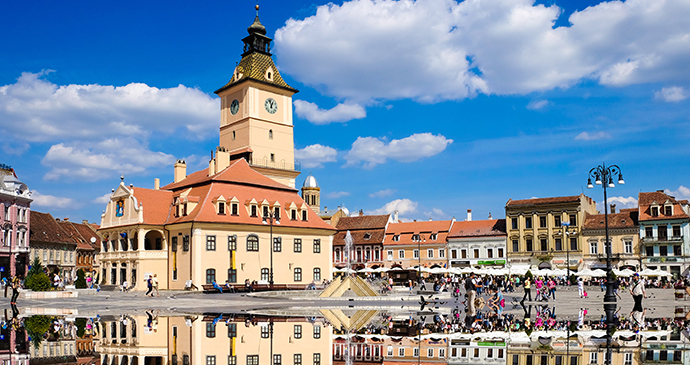
Braşov
Braşov (Brassó/Kronstadt) is the seventh city of Romania and both one of the most important cities of Transylvania and one of the major tourist attractions of the region. It has a picture-postcard setting, in a basin guarded on three sides by Mount Tâmpa Hill, Dealul Cetăţii (Citadel Hill) and Warthe Hill, and is at the heart of the Bârsa Land region, named after a local river, settled by Germans in the 13th century. While the effects of 20th-century industrial development and urban sprawl mean some pretty ugly outer districts, the medieval core of the city is delightfully preserved. Piaţa Sfatului at its heart is one of the finest squares in Romania; the Black Church just off this is the largest Gothic church in the country. Other highlights of the city include exploring the towers and bastions of the medieval walls, the terrific views from the top of Mount Tâmpa, and some great bars and restaurants in picturesque settings along pedestrianised cobbled streets in the Old Town. Given the wealth of touristic attractions in the surrounding area, from UNESCO-listed fortified churches to the ski resort of Poiana Braşov to the fairytale Bran Castle, this is a city which rewards an extended stay.
Corvin Castle is a truly magnificent sight © omihay, Shutterstock
Corvin Castle
A truly magnificent sight and a highlight of any trip to southwest Transylvania, first impressions of the Corvin Castle are magical, or perhaps more accurately fairytale, in character, from its dramatic approach over a wooden bridge across a deep gorge to the riot of square and circular towers, battlements and precipitous walls it offers. The great travel writer Patrick Leigh Fermor called it ‘fantastic and theatrical’ and ‘at first glance, totally unreal’. It is outside the centre of town, but signposted.
The numerous rooms and towers of the castle are accessed from a central courtyard. Entering the castle on the wooden footbridge resting on a series of stone piers, you first reach the square-based New Gate Tower. There is the inevitable exhibition of instruments of torture here; a sign, entirely ignored, above the door declares that children below the age of 12 may not enter. Immediately to the south of this is the Palace of Festivities, which contains two large halls. That on the ground floor is known as the Knights Hall, with a row of octagonal columns through the centre. It was the assembly place of the military officers, and today holds an exhibition of arms and armour. Immediately above this, and similarly divided by a line of columns, is the vaulted Council Hall. In the Capistrano Tower nearby is a room with an impressive Gothic fireplace, said to have been the home of the Franciscan friar St John of Capistrano, a papal legate, who became known as ‘the soldier saint’ for his work alongside John Hunyadi in the defence of Belgrade, where, like Hunyadi, he succumbed to the plague.
Retezat National Park
Established in 1935, Retezat is the oldest national park in Romania. The highest mountain range here is granite, with high peaks and glacial lakes. A more southerly range, known as the Little Retezat (Retezatul Mic), is limestone, its peaks slightly lower than those to the north, and its surface drier, with caves and deep valleys.
The highest point of the Retezat range, Peleaga Peak, rises to 2,509m, just 35m lower than Moldoveanu Peak in the Făgăraş Mountains, the highest point in Romania. The Retezat Mountains contain more than 20 peaks above 2,000m, more than any other range in Romania. The main range of the Retezat Mountains is also known for its chain of glacial cirque lakes. Lacul Bucura, at an altitude of 2,040m below Peleaga Peak, is the largest glacier lake in Romania, with a length of some 550m. And Lacul Zănoaga further west takes the title of Romania’s deepest glacial lake, reaching a maximum depth of 29m.
There is a particularly rich flora in the natural park, with colourful plants to be found here including the glacier pink, yellow gentian, red vanilla orchid, edelweiss and globeflower. Animals found in the park include bears, wild boar, lynx, wolves and chamois. Farming communities on the edge of the park have land-use rights in the alpine pastures for their livestock. The area of the Gemenele Scientific Reserve within the park has a particularly high degree of protection: visitor access is controlled here and camping or the lighting of fires is not allowed within the scientific reserve.
The massif is crossed by marked trails, and offers fine panoramas of mountain peaks and glacier lakes, frequently enjoyed in solitude.
Sarmizegetusa Regia
The atmospheric ruins of the Dacian capital at Sarmizegetusa © Balate Dorin, Shutterstock
The most important and by far the most visited of Transylvania’s Dacian fortresses is Sarmizegetusa Regia, some 23km south of Coştesti along a road which runs through the attractive Oraştie River valley. It was the capital of the Dacians before their defeat at the hands of the Romans. The capital was moved here by Burebista, who ruled in the 1st century BC, from the town of Argedava in present-day southern Romania, and reached its height under King Decebal a century and a half later. It was partially dismantled in AD102 by the Romans, following their victory in the First Dacian War, and definitively destroyed in the Second Dacian War in AD106. The Romans established a garrison here and later, when setting up the capital of Roman Dacia some 40km away, named it after the Dacian site, as Ulpia Traiana Sarmizegetusa.
As you drive towards the site there is a small building on the left-hand side of the road at the site entrance, offering a missable exhibition on Dacian gold. From the car park you walk up an easy cobbled path for a further 1.5km to the site itself. This brings you into the west gate of the city, and the fortress area, where the walls are constructed of large stone blocks. From here, the marked Visitor Route 1 heads down the hill beside an ancient road paved with limestone slabs, and probably originally used for processions, to the sacred area. This is laid out on impressive artificial terraces. On the upper terrace the Large Andesite Temple displays the andesite column bases of a building which had six rows of ten columns each. A lower terrace includes a mix of rectangular and circular temple bases, including the Large Circular Temple, the focus of most of the photographs of the site, where some wooden columns have been rather speculatively placed in response to archaeological evidence of woodenposts plastered with clay. This temple dominated the sacred area, but was destroyedby the Romans. Another, smaller, circular temple lies nearby. Also on this terrace are the remains of two quadrilateral temples and the remarkable circular andesite altar, comprising a central disc surrounded by ten ‘rays’ made of andesite slabs. It is believed that sacrifices would have been performed here. On the lowest terrace, in the southern part of the sacred area, is a limestone temple, rectangular in form, with 60 circular column bases on which wooden columns once stood.
Back up in the fortress, Visitor Route 2 takes you around the fortress walls, past the south gate, returning to the main entrance.
Sibiu
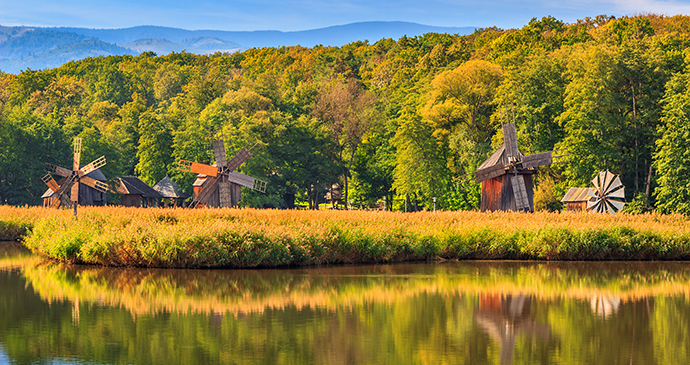
Sibiu (Nagyszeben/Hermannstadt) is one of the most visitor-friendly cities in Transylvania, and a great place to explore on foot. The old part of the city has two levels. The ‘Upper Town’ contains most of Sibiu’s historic sites, which are handily located around three charming adjacent squares, Piaţa Mare (Great Square), Piaţa Mică (Little Square) and Piaţa Huet (Huet Square). The ‘Lower Town’ is an appealing tangle of old houses and cobbled streets. Connecting the Upper and Lower towns are dozens of tunnels, stairways and hidden passages, emerging suddenly into sun-drenched, pastel-painted squares, which are fun to explore. The city offers stretches of medieval walls, a Gothic cathedral and Baroque palaces, and has two important museum complexes: one a group of museums under the Brukenthal label, with the remarkable collections of an 18th-century Governor of Transylvania at its heart, and the second the ASTRA complex, the best open-air museum in Transylvania. Add to this a busy cultural calendar, including a theatre festival of European importance, an extensive range of accommodation options and some impressive restaurants, and it is easy to see why Sibiu is many people’s favourite Transylvanian city, and a place that rewards an extended stay.
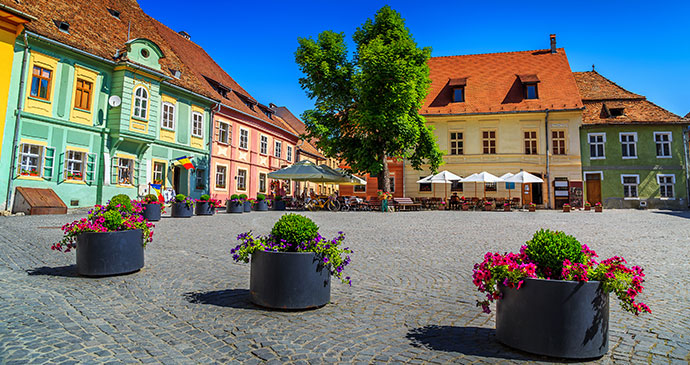
Sighişoara
Situated 55km southwest of Târgu Mureş, Sighişoara (Segesvár/Schassburg) is the archetypal Transylvanian town, just how we imagine it. The 12th-century Saxon citadel town does not disappoint and everything looks like a Dracula film set, from the dusty lower town to the steep climb up to the citadel itself, adorned by a fairytale clock tower, the covered wooden steps up to the Gothic church on the hill and the ancient medieval houses lurching into narrow cobble-stoned streets.
Sighişoara has a great atmosphere that even the cheesy Dracula souvenir shops cannot diminish. The historic centre of the town is a UNESCO World Heritage Site and a miss-at-your-peril item on the Transylvanian tour agenda.
Walking through the ancient cobbled streets, sloping to the middle where ancient shallow drains ran, you can admire the crumbling burghers’ houses in the walled citadel district, each one a little shabby with pastel green, custard or plum paint peeling from beneath the shuttered windows, but still evocative of a more magical time. The walls of the citadel include nine surviving towers, the most impressive being the Clock Tower (Turnul cu Ceas), once home to the city hall and whose spire dominates the Sighişoara skyline. Visitors reach the citadel’s inner treasures through an arch in the tower, climbing up a steep, cobbled path.
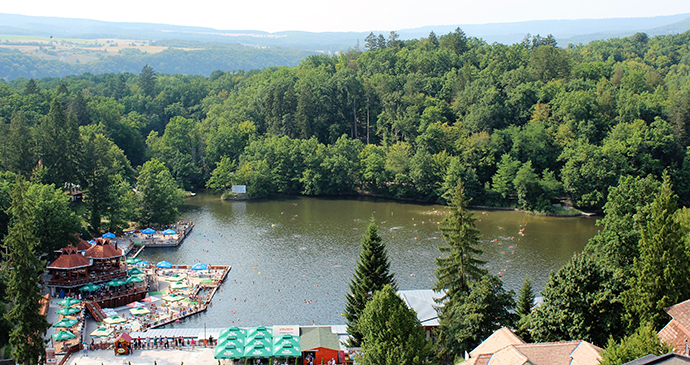
Sovata-Băi
The town of Sovata (HU: Szováta) and adjacent resort of Sovata-Băi (HU: Szovátafürdő) are located in a beautiful wooded valley in a salt-rich region known as the Ţara Sarelui/Sóvidék (Salt Country). Sovata-Băi was a popular spa resort in the late 19th and early 20th centuries and, unlike some other Romanian spas, has seen considerable investment following the collapse of the Communist regime, even if some of its places to stay are rather spartan. Today the resort is a mix of attractive wooden-walled villas with little spires and large Communist-era hotel complexes that have undergone various degrees of refurbishment.
The resort centres on the salty waters of Lacul Ursu (Bear Lake), which gets packed out at the height of summer, mostly with Hungarian and domestic tourists. Lacul Ursu is apparently the largest heliothermal salt lake in Europe; its particularly strong heliothermal properties arising because of a rain-fed less salty stratum overlying the saltier waters below, which helps to trap solar energy in the latter. Indeed, the 2-hour pause in the middle of the day when swimming is not allowed is not an example of poor tourism planning but is scheduled in order to preserve the heliothermal properties of the water.
It sits within the 79ha Bear Lake Nature Reserve (Rezervaţia Naturală Lacul Ursu) which houses several smaller salt lakes: Aluniş (Hazelwood), Mierlei (Blackbird), Roşu (Red) and Verde (Green). There is also the freshwater Lacul Paraschiva, and the rock salt mound just beyond Red Lake known as Muntele de Sare. There are many footpaths and marked trails around the lakes, which make for pleasant walks.
Transfăgăraşan Highway
Route DN7C runs north–south for some 90km, from a junction with the E68 Sibiu–Braşov highway in Transylvania, southwards to a village named Bascov near the city of Piteşti in Wallachia. Climbing to a height of some 2,042m, it is the second-highest paved road in Romania after the Transalpina, and makes for a spectacular drive. Its international fame was boosted by a 2009 episode of the BBC TV series Top Gear, when the host Jeremy Clarkson enthusiastically pronounced it ‘the best road in the world’.
Both because of the spectacular nature of the scenery and the challenging features of the road, with its numerous hairpin turns and steep ascents, conquering the Transfăgărăşan has become a target not just for drivers and motorcyclists, but is also a frequent component of charitable cycling challenges, and you may even see people attempting the climb using even more difficult means of transport, like roller skis.
Note that the highway is only open during late summer. The most mountainous central section between Bâlea Cascadă in Sibiu County and Piscu Negru in Argeş County, Wallachia, is typically shut between 1 November and 30 June, but these dates are subject to modification based on the weather conditions, and if you are intending to drive the route close to its usual closure times, you should check before you set out that the road is open with the Dispeceratul Drumuri Naţionale.
Turda Gorge
Turda Gorge (Cheile Turzii) is a drive of some 15km northeast of Turda. Head for the village of Petreştii de Jos, where you turn left onto a rough track, reaching a place to park the car after 1km. It offers a fascinating (if far from level) walk along the side of a stream at the base of 300m limestone cliffs, which are also a major destination for rock climbing. The karst environment is home to some unusual plants like the twisted-leaf onion (Allium obliquum), otherwise mostly associated with central Asia. The 3km-long gorge has a large variety of morphological features: caves, fossils, towers and arcades formed by the river’s repeated attempts to penetrate the limestone walls. Over the wooden bridge next to the car park is a small campsite. There is, in theory, an admission fee for the gorge, but the booth is usually shut.
Zărneşti: The Libearty Bear Sanctuary
Run by local NGO Milioane de Prieteni, with support from the UK-based charity World Animal Protection, the Libearty Bear Sanctuary is a remarkable place, with some 88 bears, mostly living in three large enclosures in 69ha of oak forest. Another five smaller enclosures cater for bears with specific problems. All of the bears in the sanctuary were rescued from captivity, and many of their tales are truly harrowing, such as that of Max, the blind bear from Sinaia who for years was chained up near Peleş Castle, where visiting tourists would pay to have their photo taken with him. They are also setting up a Teddy Bear Museum here centred around two huge bears donated by British bookmakers William Hill, which were originally used in a promotional campaign to encourage punters to take a flutter on the sex of a royal baby. Other bears have been donated by celebrities ranging from Brigitte Bardot to Luna Lovegood. There are also enclosures for wolves and deer. And yes, there are bears here named both Baloo and Yogi.
Related books
For more information, see our guide to Transylvania:
Related articles
Sit back and enjoy this kaleidoscope of colours.
If you’re looking for an action-packed activity holiday Transylvania is the place for you.
Transylvania is home to many impressive castles, palaces and fortresses. Here are eight of the best.
There are many national parks in Europe that remain fairly unknown. Here you can discover 14 of the best. Why miss out on visiting somewhere spectacular?
Check out these classic coastal routes and steep mountain switchbacks
